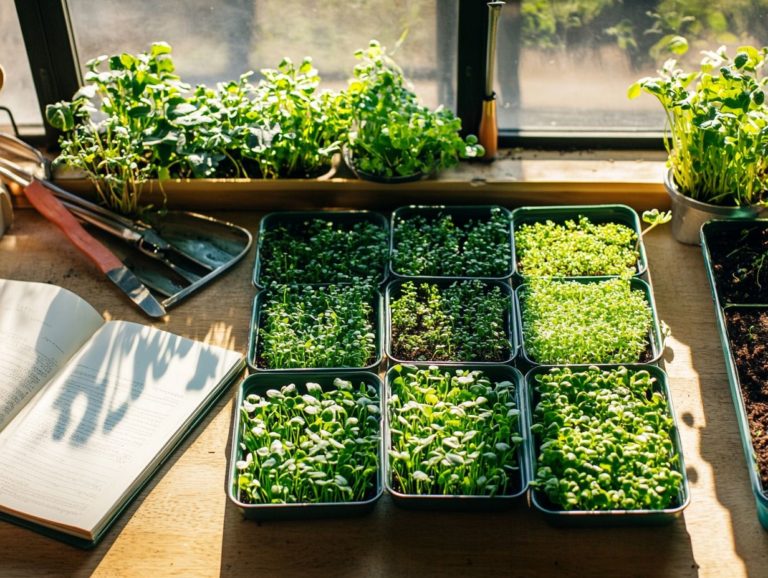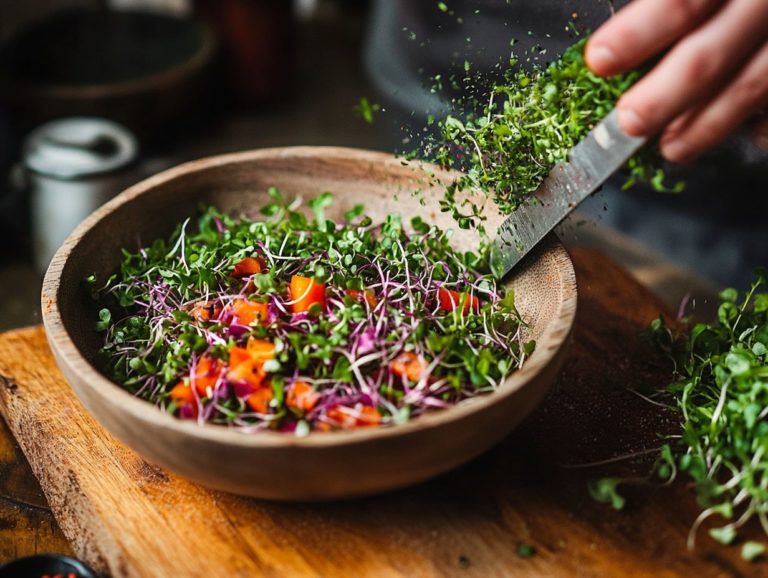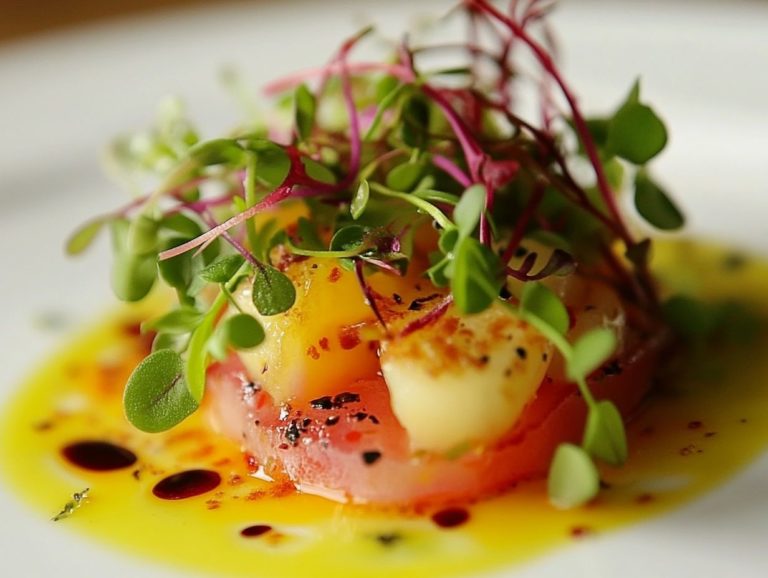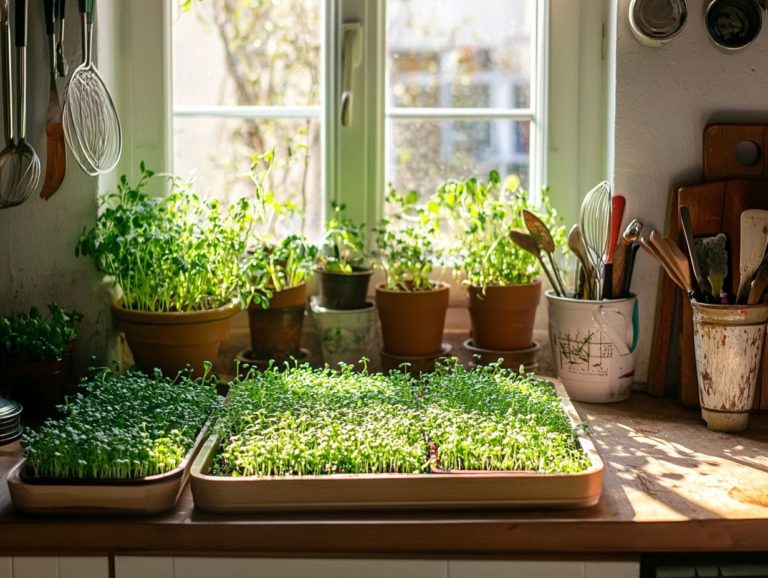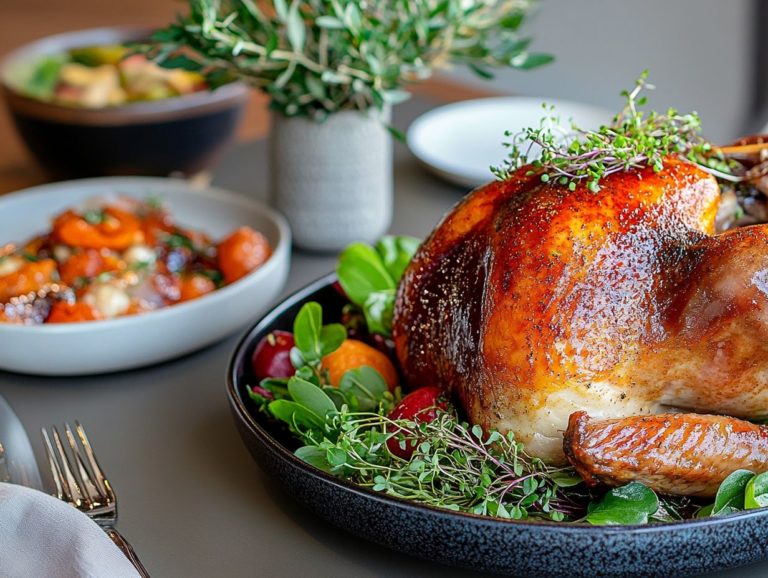How to Create a Microgreen Recipe Book?
Discover the amazing benefits of microgreens now! Microgreens are more than just a trendy garnish; they pack a powerful punch of flavor and nutrition that can elevate any dish you create.
This article showcases their impressive nutritional value along with their vibrant colors and textures, demonstrating how easy it is to incorporate microgreens into your recipes.
If you re passionate about cooking and wish to share your love for these tiny greens, you ll find guidance on crafting a captivating microgreen recipe book.
From selecting the right varieties to marketing your finished product, this guide will inspire you at every turn. Dive in and discover how to transform your culinary creativity into a published treasure!
Contents
- Key Takeaways:
- Benefits of Incorporating Microgreens in Recipes
- Your Guide to Crafting a Delicious Microgreen Recipe Book!
- Organizing and Formatting Your Recipe Book
- Promoting and Selling Your Microgreen Recipe Book with MBS Publishing LLC in Atlanta, Georgia
- Frequently Asked Questions
- What are microgreens and why should I create a recipe book for them?
- Choosing the Perfect Microgreens for Your Recipes
- What Equipment Do I Need to Create a Microgreen Recipe Book?
- Generating Recipe Ideas for Your Microgreen Recipe Book
- Can I Include Non-Traditional Recipes?
- Organize Your Microgreen Recipe Book Like a Pro
Key Takeaways:
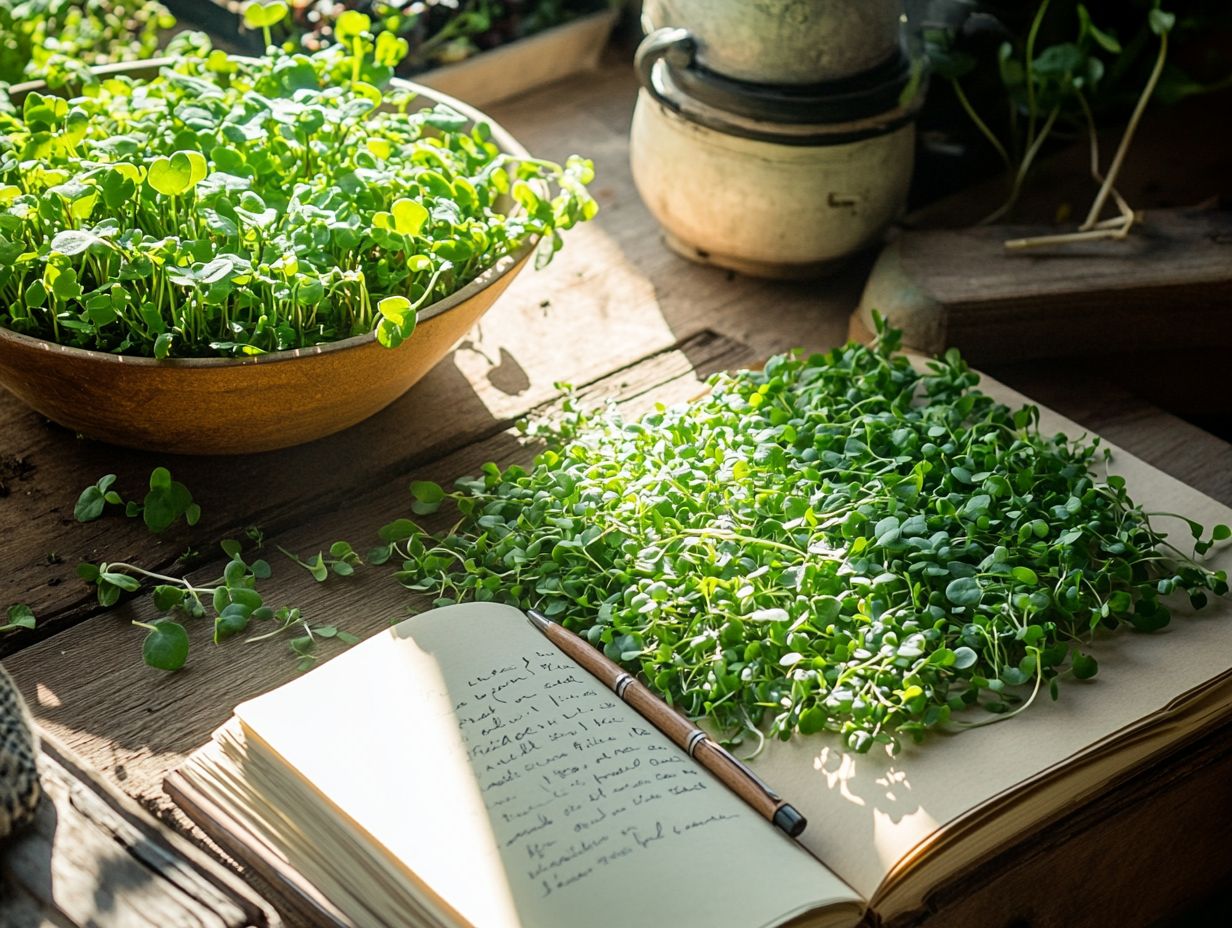
- Enhance the nutritional value of your meals by incorporating microgreens in your healthy recipes.
- Select the right microgreens for your recipe by considering their taste and texture.
- Boost sales and reach a wider audience by utilizing effective marketing strategies and collaborating with microgreen producers.
What are Microgreens?
Microgreens are the young, edible wonders you harvest just after the first true leaves have unfurled. These vibrant greens, which include delightful varieties like arugula, basil, and radish, are bursting with nutrients and culinary potential. They re an excellent choice for anyone looking to elevate their meals with fresh flavors and added health benefits.
With their rich colors and intense flavors, microgreens can transform an ordinary dish into something extraordinary. Varieties such as cilantro, mustard, and beet greens not only add a splash of color but also infuse your meals with unique tastes and aromas. If you’re interested in learning how to promote microgreens in my café, these vibrant ingredients can be a fantastic addition to your menu.
You can grow these tiny powerhouses using methods like hydroponics a method of growing plants without soil, using nutrient-rich water instead or soil-based systems. This makes them a perfect fit for your home environment, even if space is tight. Their concentrated nutrition means that even a small handful can significantly enhance your diet, providing vitamins A, C, E, and K, along with essential minerals.
As gourmet chefs have discovered, incorporating microgreens into salads, garnishes, or as toppings can elevate the visual and flavor profiles of any dish. They truly are a must-have for both amateur cooks and culinary professionals looking to impress.
Benefits of Incorporating Microgreens in Recipes
Incorporating microgreens into your meals not only elevates the nutritional profile, but also enhances your culinary experience. These tiny greens bring vibrant colors and fresh flavors to your recipes, making them an exceptional addition to any healthy diet.
This project provides families the opportunity to discover exciting meal upgrades, making everyday meals special while reaping the benefits of these nutrient-rich ingredients.
Nutritional Value and Health Benefits
Microgreens are hailed as a superfood, and for good reason. Their remarkable nutritional profile often surpasses that of their mature counterparts, offering higher concentrations of vitamins, minerals, and antioxidants. This means they can provide a range of health benefits, from reducing the risk of chronic diseases to enhancing mental alertness.
These vibrant greens think kale, broccoli, and radish not only brighten up your plate but also deliver a significant nutrient boost to your family’s meals. Packed with vitamins C, E, K, and beta-carotene, they fortify your immune system, promote radiant skin, and contribute to overall well-being. To maximize their benefits, consider learning how to plan a microgreen garden. Research shows that adding microgreens into your diet can elevate antioxidant levels in your bloodstream, effectively combating oxidative stress.
By adding nutrient-dense varieties like arugula, which is particularly rich in calcium and magnesium, you re not just amping up your nutritional intake; you re also introducing exciting flavors to salads and sandwiches. This makes the journey of healthy eating enjoyable for everyone at the table.
Your Guide to Crafting a Delicious Microgreen Recipe Book!
Creating a microgreen recipe book is an enriching endeavor that enables you to curate a diverse collection of healthy recipes. This project showcases the versatility of microgreens in culinary creations, spanning from vibrant salads to satisfying main dishes and even delightful desserts.
Start your journey today and discover the joy of cooking with microgreens!
Choosing the Right Microgreens for Recipes

Choosing the right microgreens boosts flavor and nutrition in your dishes. Consider the type of dish you re preparing, the fresh flavors you wish to highlight, and how easy they are to grow in your home garden.
Whether you’re crafting a vibrant salad, a hearty soup, or a gourmet sandwich, integrating microgreens can elevate your culinary creations. For example, the peppery notes of arugula microgreens pair exquisitely with roasted vegetables. If you’re interested in incorporating these greens into your meals, check out our guide on how to start growing microgreens. Meanwhile, delicate pea shoots introduce a refreshing crunch to light pasta dishes.
If you’re new to gardening, you’ll find that varieties like radish and mustard greens sprout quickly and require minimal effort, making them ideal for beginners. These lively greens can easily enhance your recipes—just scatter them over a bowl of soup or fold them into an omelet. They not only improve flavor but also add a delightful visual appeal to your dishes. To learn more about growing these plants, check out the best resources for microgreen growing.
Tips for Recipe Development
When crafting recipes that spotlight microgreens, aim to create meals that are not just nutritious but also kid-friendly, appealing to the entire family. Keep the cooking process simple yet engaging; this can spark children s interest in healthy eating habits.
To accomplish this, focus on balancing flavors to design dishes that are both wholesome and delicious. Think creatively about incorporating microgreens in ways that will delight young taste buds. For tips on how to get started, check out this guide on creating a microgreen variety garden. Picture adding vibrant microgreens to smoothies or using them as eye-catching toppings on homemade pizzas; these touches make meals visually enticing.
Spark creativity in the kitchen! Let kids choose their favorite ingredients and play with colors and textures. Highlight the nutritional benefits of microgreens, making it clear how these tiny greens can enhance their health. If you’re interested in incorporating microgreens into your home or even considering a business venture, check out this guide on how to start a microgreen business. This helps kids appreciate healthy foods, setting the stage for healthier choices throughout their lives.
Organizing and Formatting Your Recipe Book
Organizing and formatting your microgreen recipe book is essential for elevating readability and user experience. By ensuring that readers can effortlessly navigate through sections dedicated to healthy recipes, cooking tips, and nutritional information, whether in print or as an e-book, you create a warm, welcoming space that invites readers to explore and enjoy.
Design and Layout Considerations
The design and layout of your recipe book are crucial for capturing your readers attention. A well-structured layout with stunning visuals enhances your readers experience, whether they hold a print edition or swipe through an e-book.
Use vibrant colors that reflect the freshness of microgreens to create an inviting ambiance. The meticulous selection of fonts plays a vital role in enhancing readability. Opt for legible typefaces, particularly for headings and instructions, to guide your readers seamlessly through the content. Additionally, consider incorporating tips on how to make a microgreen salad to engage them further.
Strategically placed images of microgreens, perhaps paired with their corresponding recipes, not only highlight their versatility in the kitchen but also keep your audience engaged.
Striking the right balance between text and visuals can turn a simple recipe collection into an enticing gastronomic journey, encouraging cooks to experiment and savor every moment.
Start experimenting with microgreens today!
Including Nutritional Information
Incorporating nutritional information into your recipe book is vital for health-conscious readers who want to grasp the benefits of microgreens and other ingredients. This information helps you make informed dietary choices while enjoying delicious, healthy recipes.
By providing a detailed breakdown of nutrients for each recipe including macronutrients like proteins, fats, and carbohydrates, as well as essential vitamins and minerals you enable yourself to tailor your meals to meet specific dietary goals. This level of transparency fosters trust and encourages you to experiment with new ingredients while being mindful of their nutritional impact.
Providing this information in both print and e-book formats enhances accessibility, allowing you to quickly reference nutritional content whether you’re cooking in the kitchen or on the go. This approach enriches your overall cooking experience, making it both enjoyable and informed.
Promoting and Selling Your Microgreen Recipe Book with MBS Publishing LLC in Atlanta, Georgia
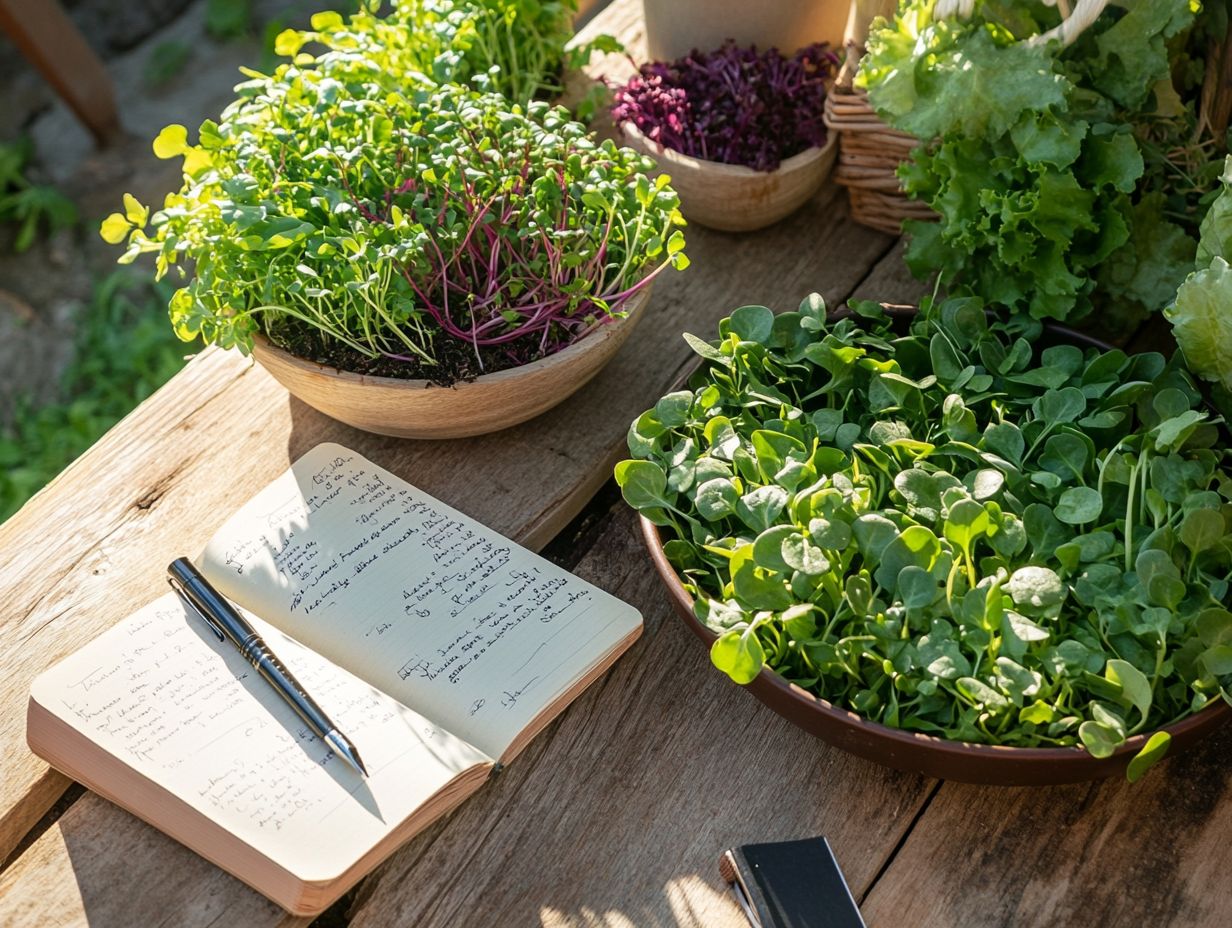
Effectively promoting and selling your microgreen recipe book demands a strategic approach that utilizes various marketing tactics, engages with social media platforms, and fosters direct interaction with your target audience. This multi-faceted strategy enhances visibility and encourages readers to discover the numerous benefits of incorporating microgreens into their meals.
Marketing Strategies and Platforms
Utilizing a variety of marketing strategies and platforms is crucial for reaching potential readers of your microgreen recipe book. By targeting social media channels and food-related blogs, you can create buzz and foster community engagement around the healthy recipes featured in your e-book.
To connect effectively with your audience, focus on visually driven platforms like Instagram and Pinterest. These spaces are perfect for showcasing mouth-watering images that highlight the vibrant colors and fresh appeal of microgreens. Additionally, you can explore how to use microgreens in cooking to inspire your culinary creations.
Create engaging content like step-by-step recipes or behind-the-scenes videos to entice viewers and encourage them to try out your recipes. Collaborating with popular food bloggers can amplify your reach; their endorsements add credibility that can t be overlooked.
Explore paid advertising opportunities on these platforms to expand your visibility and target specific demographics, ensuring your recipe book attracts passionate cooking enthusiasts.
Collaborating with Microgreen Producers
Collaborating with microgreen producers can significantly enhance your recipe book’s credibility and reach. By creating networking opportunities, you promote healthy recipes while highlighting the importance of fresh, locally sourced ingredients in your culinary creations.
Co-hosting events like cooking classes or farm-to-table dinners allows you to engage directly with audiences eager to learn about the benefits of incorporating microgreens into their meals. Including insights and anecdotes from these local growers in your book offers readers a deeper understanding of the growing process and the nutritional advantages of fresh produce, as well as how to grow your favorite microgreen varieties.
To elevate both your recipe book and the visibility of the producers, leverage social media platforms for cross-promotion or organize collaborative appearances at farmers’ markets, where you can offer tastings featuring their products. Additionally, consider sharing how to incorporate microgreens into meals to inspire others. These strategies build community connections and foster trust and authenticity around your culinary endeavors.
Frequently Asked Questions
What are microgreens and why should I create a recipe book for them?
Microgreens are young, edible plants harvested just after the first leaves have developed. They are packed with nutrients and add flavor to dishes. Creating a recipe book for microgreens allows you to explore new and creative ways to incorporate these nutritious greens into your diet.
Try out these recipes and discover the delicious potential of microgreens!
Choosing the Perfect Microgreens for Your Recipes
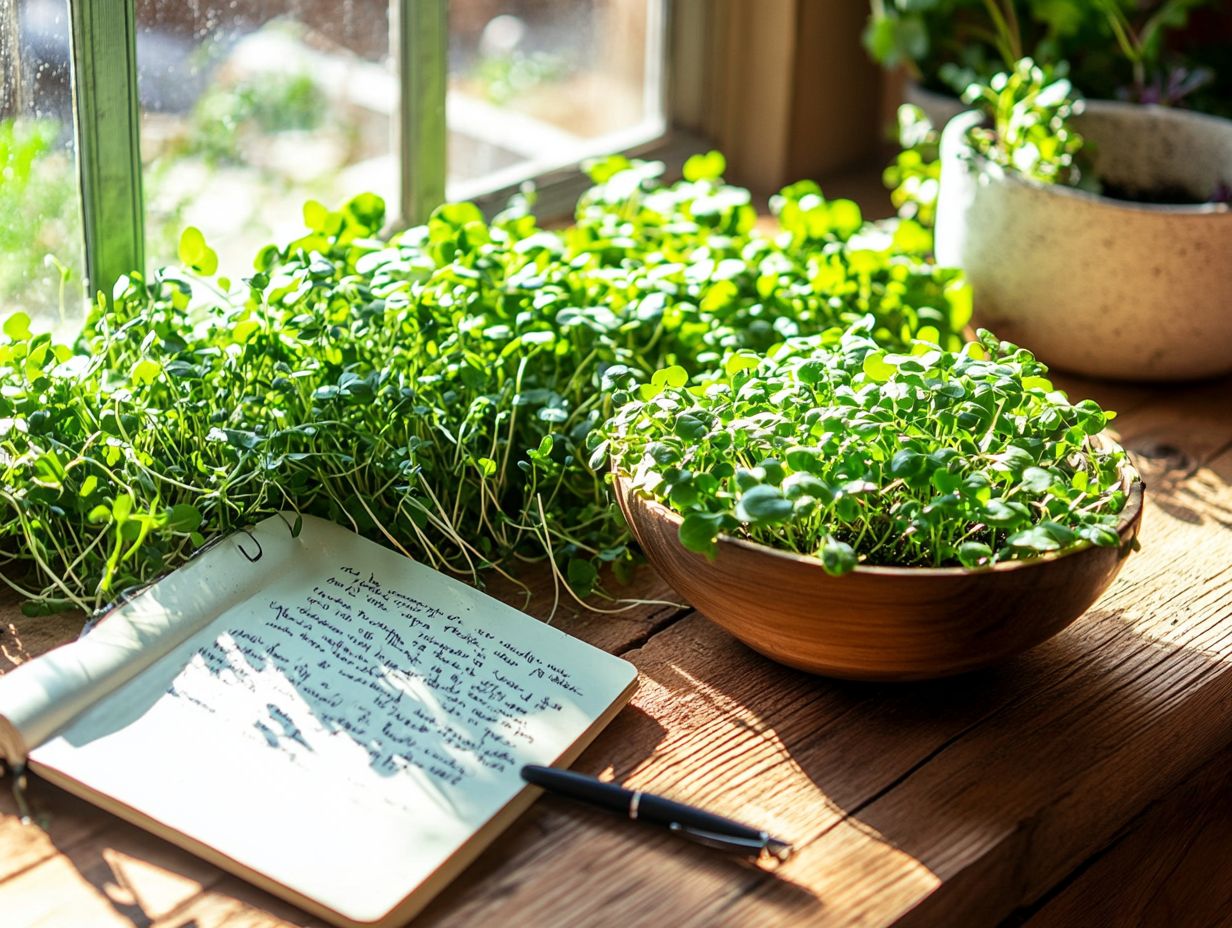
When choosing microgreens for your recipe book, consider their flavor, texture, and color. Think about how they will complement other ingredients.
What Equipment Do I Need to Create a Microgreen Recipe Book?
You don’t need any special equipment to create a microgreen recipe book. A camera or smartphone for taking pictures and a computer or notebook for recording your recipes are all you need to get started.
Generating Recipe Ideas for Your Microgreen Recipe Book
There are many ways to come up with recipe ideas. Try incorporating microgreens into your favorite dishes or looking for inspiration from other recipe books or online resources. Get creative and explore new flavor combinations!
Can I Include Non-Traditional Recipes?
Absolutely! Including non-traditional or unconventional recipes can make your microgreen recipe book stand out. Think outside the box and experiment with unique dishes.
Organize Your Microgreen Recipe Book Like a Pro
There is no right or wrong way to organize your recipe book. Sort your recipes by dish type, main ingredient, or theme for a fun and organized layout! Choose a method that works best for you and your audience.

